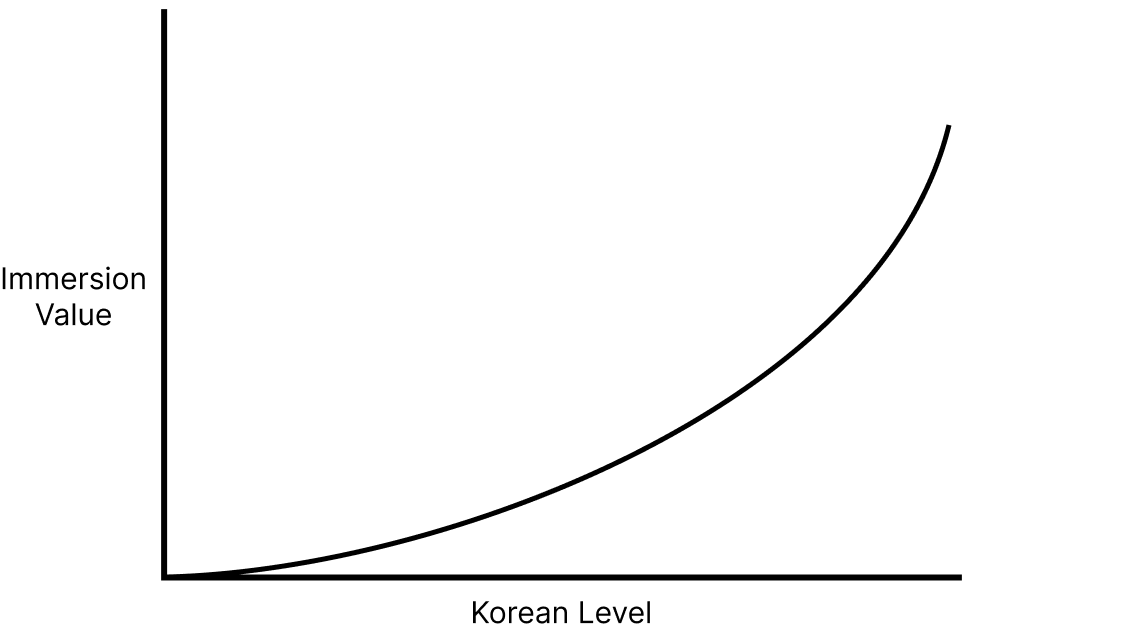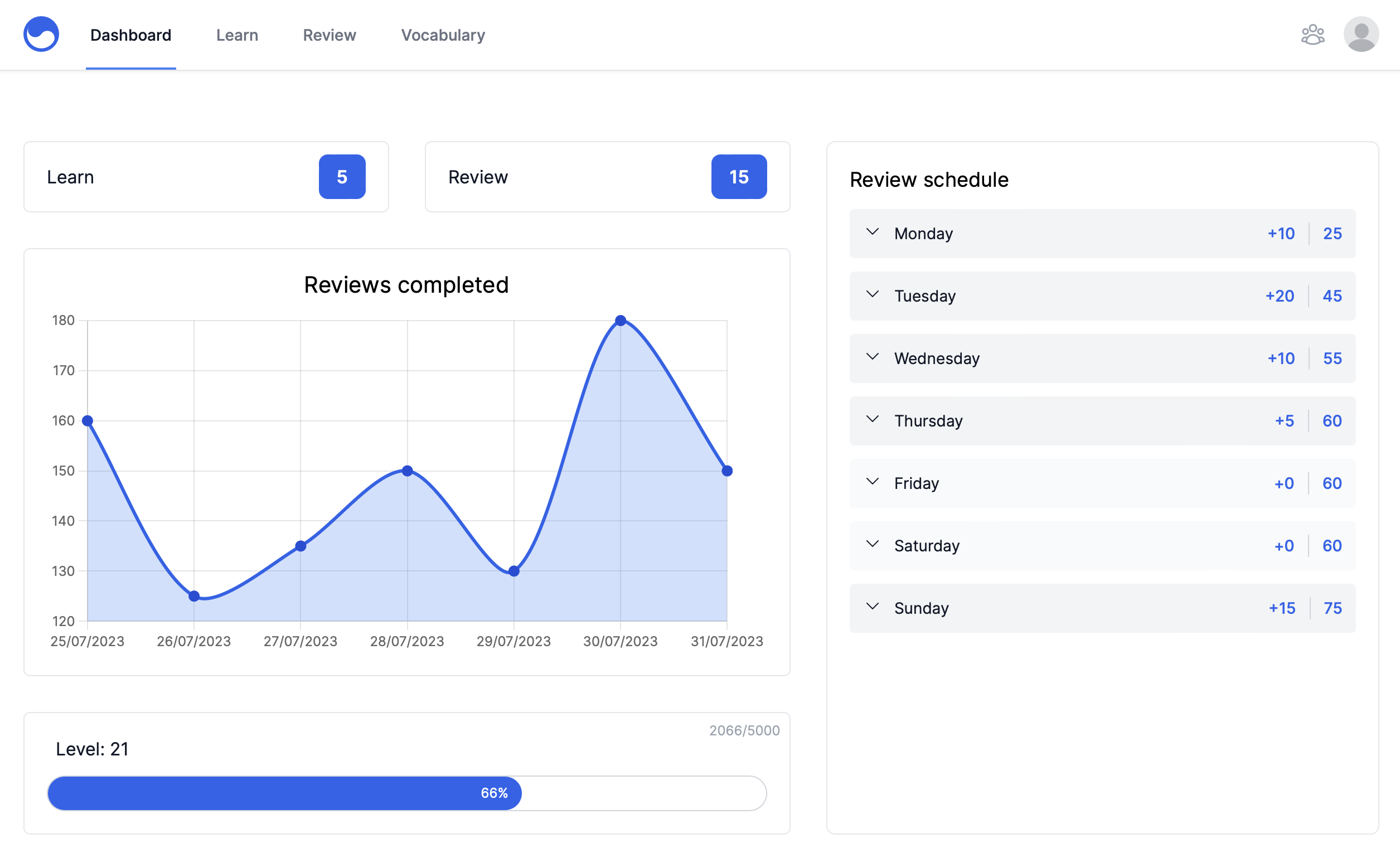Learn Korean: A 'step-by-step' guide to achieving fluency
This guide outlines methods for learning Korean in the long term and progressing towards fluency. By the end we will have established an effective routine to allow you to achieve your language learning goals.
To get started you first need to learn Hangul, which is the Korean alphabet. This will give you the ability to start reading Korean words. We have put together a guide to learning Hangul, which will teach you the 24 basic letters and 16 additional sounds used in Korean. Once you feel confident with Hangul we can move onto the main parts of learning Korean:
- Vocabulary. Increases your understanding of Korean, making immersion more valuable and enjoyable.
- Grammar. Increases your comprehension of Korean, allowing you to better understand how the language functions.
- Immersion. Brings vocabulary and grammar together, allowing you to learn new concepts and review old concept while consuming your favourite Korean media.
In this guide we will cover each one of these topics individually, explaining the importance of them when learning Korean. Then bring them all together at the end to create a language learning routine.
Setting expectations
Before we begin it is important to note that Korean is hard but not in the sense that it is complicated, as you will see in this guide the process to learn Korean is actually rather straight forward. However, Korean is hard in the sense that it takes a very long time to reach fluency. And in this time it is very likely that at some point you are going to struggle with motivational issues.
Although it may be discouraging to hear that learning Korean takes a long time and that you will probably suffer from motivational issues at some point along the journey, being aware of this is very important as it makes you better prepared to deal with it when the time comes. And when it does, the best thing you can do is remind yourself of your language learning goal, to gain back some of that motivation, and simply keep pushing forward.
"If you expect disappointment, then you can never really be disappointed."
Learning the basic grammar
To get started we need a resource where we can learn the basics of Korean grammar. This can be a textbook, website or youtube series. The important part is to find something that you enjoy. Reason being that, when learning a language consistency is much more important than efficiency. This is because language learning is a linear skill, meaning that as long as you put in the time, success is pretty much guaranteed. Hence, it is better to use a resource which you enjoy and regularly use, over a resource which is more efficient but you hate using.
When learning grammar you should not be focused on trying to understand it perfectly, but being aware of it and able to recognise it instead. This is because grammar is not always consistent nor logical, meaning the only way to develop an intuitive understanding of it is to see it used thousands upon thousands of times in different contexts. Rather than reading page long explanations of it which you cannot yet understand. And for this, we are going to be using immersion.
Understanding immersion
Immersion is the process of learning a language through consuming media in that language, such as reading books, watching TV series or listening to podcasts. As you consume this content you will naturally learn new grammar and vocabulary through seeing them used repeatedly in different contexts.
This is the same way that your brain learned your native language when you were a kid. But we are going to be studying as well as immersing, to help speed up the process.
As a beginner immersion is often difficult as you can't understand much of what you are consuming. Hence you should focus on recognising commonly used words, phrases and listening to how the language is spoken rather than understanding everything. Then, as you get better at Korean you will understand more, making immersion not only more enjoyable but also more valuable.

Eventually, once you become good enough at Korean, you can learn only from immersion without the need for studying any other resources along side it. Ideally this is the stage we want to reach as fast as possible, but we still need to make sure we actually make it there. And the best way to start understanding more during our immersion is by learning more vocabulary.
Growing your vocabulary
To learn vocabulary we are going to be using a flash card based spaced repetition system. The flashcards should contain a Korean word, example sentence and have pronunciations for both. After learning the flashcard it should then be placed into a spaced repetition system where you are quizzed on it after increasing intervals of time to ensure memorisation.
We recommend using our tool KVocab to learn Korean vocabulary. It teaches the 5000 most common Korean words to rapidly improve your understanding of Korean and help you get the most out of your immersion right away. It also gives you full customisability over the spaced repetition system, allowing you to configure the review intervals and number of new daily vocabulary to fit your schedule.

But if our tool isn't for you, then you could use another flashcard based spaced repetition tool instead such as Anki or Quizlet.
Bringing it all together
Now we are know what we need to do to learn Korean and why we need to do it, it's time to bring it all together into a routine which we can follow.
Firstly, each day we should learn our new vocabulary and complete any outstanding reviews from our spaced repetition system. This is the most important thing to do as it prevents our reviews from stacking up and becoming insurmountable.
Then we should immerse ourselves in our chosen form of Korean media. This should only be for a small amount of time for beginners (5-10 mins) when immersion is difficult, and get progressively longer as understand more Korean and find immersing more enjoyable and valuable.
Finally, a few times a week when you should spend 10-20 minutes learning a new grammar point from your chosen resource.
If you stick to this routine then you will undoubtably be able to reach your language learning goal, whatever that may be. Good luck on your journey, the KVocab team.